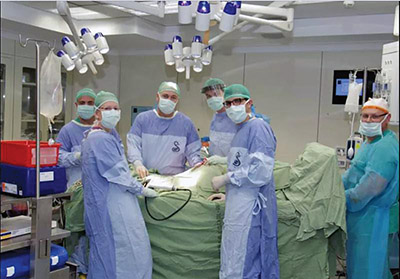
A little boy with blond curls leaves the Shabbat table to get a cup from the upper cupboard. He drags the stepladder to the counter and climbs on top. Just as he is about to take a cup, his foot strikes the electrical cord of the nearby hot-water urn. The scream that ensues is so blood curdling that tears sting your eyes and a chill runs up your spine.
The scene is one of many in a series of videos produced by Nurit Michelson, a nurse at Sheba Hospital’s Burn Unit. She said this and the other stories are based on real-life events.
In Israel, there are thousands of children who get burned each year; a large percentage of those are under the age of 14.
This week is Burn Awareness Week in Israel and the United States.
Sheba Medical Center, Tel Hashomer, held a series of events this week to focus on burn education in the country. Doctors, nurses and volunteer paramedics used the opportunity to offer presentations to elementary schools throughout the country about how to prevent burns at home and how to treat them if they occur.
According to Michelson, 80 percent of burns happen at home.
“If we would talk about it more and tell parents, we might be able to reduce burns,” said Michelson. “Burns rarely happen on purpose.”
Michelson said the goal of the elementary school education is to empower youth to bring the message of the importance of preventing burns home to their families. Kids, she said, can serve as a mouthpiece for reminding Mom to put her cup on a higher counter, or for policing their little brothers and sisters to stay away from the hot-water urn or hot bath.
Kids will also be taught that burns should initially be treated by running the affected area under cold water for up to 20 minutes. If it is a small burn, it can be treated with burn cream. More intense burns and burns in dangerous areas of the body need to be treated at an emergency medical clinic or hospital.
The Sheba Hospital Burn Unit was founded in 1973 during the Yom Kippur War to treat the numerous burn patients that arrived from the battlefield. Today, the unit is recognized as the National Referral Unit for treatment of burns in Israel. It is also the only burn unit in Israel with respiratory and intensive care provisions provided in the unit itself.
Michelson said most burns happen on Fridays and Saturdays and to Arab or ultra-Orthodox families.
“We call them Shabbat burns,” she said.
Among the ultra-Orthodox, the burns happen from Shabbat plates, crock-pots and hot-water urns. Among Bedouin Arabs, there are children who literally fall into the fire pit or pot in which some members of these communities still cook their communal meals.
Sheba’s Burn Unit is poised to see an increase in patients this time of year because of Purim, a holiday on which young kids celebrate with firecrackers. Michelson cautioned that Purim firecrackers are explosives and she has seen incidents that involve blindness and amputated fingers, as well severe burns to the hands, fingers, chest and face after firecrackers exploded prematurely.
“Just don’t bring these explosive devices home,” said Michelson. “It’s crazy! They are not safe.”
The results of a major burn can be life altering, Michelson explained.
While a severe burn involves the skin in the first minutes, it can rapidly become systemic. Patients who are badly burned can suffer from recurrent and resistant infections involving the kidneys and the cardiovascular and respiratory systems.
Michelson has countless stories. She related the story of a young mother who was out at a cafe drinking coffee with her newborn. The coffee spilled on the baby, and he was severely burned. The child was hospitalized for a month and had to undergo skin replacement surgery.
“The mother was in so much pain from this, too” said Michelson. “Parents always feel guilty, even if they are not really guilty. It is just terrible and really breaks your heart.”
Another heartbreaking story is of a girl who 16 years ago was playing with her brother in the kitchen when the hot-water urn tipped over, burning her all over her body, including her face. She since underwent 18 surgeries and says it is a miracle she is alive. In a letter, the girl describes how kids make fun of her because she looks like a chipmunk with her swollen face.
There are countless stories, Michelson said, “but the best stories are the ones that cannot be told because they were prevented.”
By Maayan Hoffman













